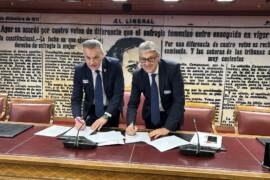© Riproduzione riservata
L’orzo è un cereale ricco di preziosi nutrienti, tra cui carboidrati, zuccheri, proteine, grassi, fibre, vitamine del gruppo B e minerali come calcio, fosforo e potassio. Nella versione tostata il prodotto risale alla prima metà dell’800 e si è poi particolarmente diffuso nel periodo autarchico precedente la seconda guerra mondiale come surrogato del caffè. In quanto non contiene caffeina, l’orzo tostato è un prodotto adatto ad essere consumati da tutti, adulti e bambini, in particolare da chi desidera evitare l’effetto eccitante del caffè. Nel dopoguerra l’orzo si è affermato come modificatore del latte destinato alla colazione dei bambini L’evoluzione delle abitudini di consumo verso un’alimentazione più sana ed equilibrata ha portato l’orzo tostato a rivolgersi anche ad un pubblico più adulto, consolidando una posizione di grande rilievo all’interno del mercato dei preparati per bevande calde.

Secondo i dati IRI le vendite di orzo e tostati naturali nei punti della distribuzione moderna nell’anno terminante a ottobre 2017 sono stati pari a 6,3 Mn/kg per un valore di 48.6 M.n/€, con un peso prevalente della versione solubile (69% del totale valore), mentre il macinato vale il 19% ed, infine, comincia a far capolino anche l’orzo tostato in capsule, che per ora vale circa il 12% a valore. Tenuto conto anche delle vendite nel retail tradizionale e delle vendite nell’Horeca (dove è diffusa anche la versione orzo & ginseng), il mercato totale può essere stimato sommariamente intorno a 9 Mn/kg per un valore di 70 Mn/€
Leader di mercato è Orzoro del gruppo Nestlè Il lancio di Orzoro sul mercato risale al 1940 a cura della ditta “Ursina Franck”, industria di succedanei del caffè, che poi nel 1971 si fuse con il gruppo Nestlè; successivamente il marchio è stato ribattezzato come Nestlè Orzoro.
Ma il gruppo produttivo più importante in Italia è Crastan, con ben due stabilimenti in Toscana, che produce sia a proprio marchio (Crastan, Orzo Pupo, …) sia a marchio di terzi (gruppi GDO e altre aziende), oltre a produrre anche Caffè. Il terzo marchio più importante del mercato è Orzobimbo, a suo tempo lanciato dalla Star, ed ora in mano al gruppo Nutrition & Santè.
The Italian Market for Roasted Barley
 Barley is a cereal rich in valuable nutrients, including carbohydrates, sugars, proteins, fats, fibres, B vitamins and minerals such as calcium, phosphorus and potassium. In the roasted version, the product dates back to the first half of the 19th century and became particularly popular in the autarchic period prior to the Second World War as a substitute for coffee. As it does not contain caffeine, toasted barley is a product suitable for everyone, adults and children, especially those who want to avoid the exciting effect of coffeine. In the postwar period, barley became established as a modifier of milk for children’s breakfast. The evolution of consumption habits towards a healthier and more balanced diet has led to the use of toasted barley also for a more adult audience, consolidating a very important position in the market for hot beverage preparations.
Barley is a cereal rich in valuable nutrients, including carbohydrates, sugars, proteins, fats, fibres, B vitamins and minerals such as calcium, phosphorus and potassium. In the roasted version, the product dates back to the first half of the 19th century and became particularly popular in the autarchic period prior to the Second World War as a substitute for coffee. As it does not contain caffeine, toasted barley is a product suitable for everyone, adults and children, especially those who want to avoid the exciting effect of coffeine. In the postwar period, barley became established as a modifier of milk for children’s breakfast. The evolution of consumption habits towards a healthier and more balanced diet has led to the use of toasted barley also for a more adult audience, consolidating a very important position in the market for hot beverage preparations.
According to IRI data, sales of barley and natural roasted products in modern distribution points in the year ending in October 2017 amounted to 6.3 Mn/kg for a value of 48.6 Mn.n/€, with a prevalent weight of the soluble version (69% of the total value), while the ground product worths 19% and, finally, barley roasted in capsules also begins to emerge, which for now worths about 12% in value. Taking into account also traditional retail sales and sales in Horeca (where the barley & ginseng version is also widespread), the total market can be estimated summarily at around 9 Mn/kg for a value of around 70 Mn/€
Market leader is Orzoro of the Nestlè group The launch of Orzoro on the market dates back to 1940 by the company “Ursina Franck”, an industry of coffee substitutes, which then merged in 1971 with the Nestlè group; then the brand was renamed as Nestlè Orzoro.
But the most important production group in Italy is Crastan, with two plants in Tuscany, which produces both under its own brand (Crastan, Orzo Pupo,…) and toll-manufacturing (GDO groups and other companies), in addition to produce also Coffee. The third most important brand on the market is Orzobimbo, which was launched by Star and is now in the hands of the Nutrition & Santè group.
Per maggiori informazioni si rimanda all’Annuario Coffitalia 2018
© Riproduzione riservata
















